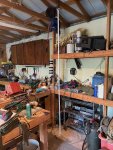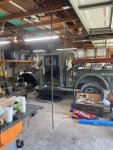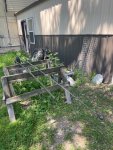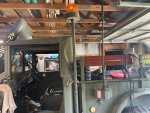This is -a- method - probably not the most efficient. The result is OK, but it is one way to approximate the military whip antenna.
The radio is a 2m amateur radio inside an AN/PRC-9 that was not salvageable - Completed Project – Modern 2m Amateur Radio inside 1950’s AN/PRC-9 – Stickelman.net
I started with a CG-144 antenna and put 1/4in PVC around the thin wire parts. If I had to do this again, I would do a more pronounced taper. I attempted a taper with layers of duct tape over the PVC. I would also find thinner tubing for the top portion.
I got fiberglass material from - Soller Composites, LLC - I ended up with fiberglass sleeve and epoxy, with shrink tube to form the last layer for smoothness. The shrink tubing removes easily after the epoxy sets leaving a nice surface. The actual fiberglass sleeve is surprisingly variable in diameter. Something like a finger handcuff, stretch to make smaller, compress to make wider.
Fiberglass is (apparently) the outer material of the standard VHF whip antennas so I did want a fiberglass layer for the texture and durability. I hung the antenna vertically to keep it mostly straight and put the first sleeve on

Putting the epoxy on is fairly messy, it is quite thin. I used nitrile disposable gloves to do this. I was able to squeeze epoxy into the glass fibers fairly well like this. It set up durable and was a good first coat. Trimming the excess from the ends was not difficult with tin snips.
Second layer of tubing I painted to give the antenna a base color of OD green and the paint did not harm epoxy adsorption and did not smear when applying second coat of epoxy. The shrink tubing for the outer layer goes on easily, the epoxy is slippery stuff until it sets.

The end result is decent, but lacks a good taper, and did not end up decently straight. This is the made antenna next to a regular VHF military whip.

I turned the end cap teardrop safety ball from wood and this likely wont survive a strike on something like a tree branch at speed, but it will be fine if I am careful. It is fixed in place with RTV.
I was able to use the AB-15 type antenna base by using a diamond grinding bit to slowly increase the size of the opening to accommodate a modern PL antenna connector.
If I had to do it again I would use an antenna that does not have the bulge in the center that the CG-144 has, probably going with a 2m hamstick or similar type. A CB firestick would work if you want to do CB. I would also use fiberglass tube for the underlayer as the PVC was flimsy and ended up giving a slight bend. I would also increase the taper with more layers of duct tape at the base and working up thinner and thinner.
It isn't too bad as it is though, much closer than what any other antenna on the commercial market would look like

The radio is a 2m amateur radio inside an AN/PRC-9 that was not salvageable - Completed Project – Modern 2m Amateur Radio inside 1950’s AN/PRC-9 – Stickelman.net
I started with a CG-144 antenna and put 1/4in PVC around the thin wire parts. If I had to do this again, I would do a more pronounced taper. I attempted a taper with layers of duct tape over the PVC. I would also find thinner tubing for the top portion.
I got fiberglass material from - Soller Composites, LLC - I ended up with fiberglass sleeve and epoxy, with shrink tube to form the last layer for smoothness. The shrink tubing removes easily after the epoxy sets leaving a nice surface. The actual fiberglass sleeve is surprisingly variable in diameter. Something like a finger handcuff, stretch to make smaller, compress to make wider.
Fiberglass is (apparently) the outer material of the standard VHF whip antennas so I did want a fiberglass layer for the texture and durability. I hung the antenna vertically to keep it mostly straight and put the first sleeve on

Putting the epoxy on is fairly messy, it is quite thin. I used nitrile disposable gloves to do this. I was able to squeeze epoxy into the glass fibers fairly well like this. It set up durable and was a good first coat. Trimming the excess from the ends was not difficult with tin snips.
Second layer of tubing I painted to give the antenna a base color of OD green and the paint did not harm epoxy adsorption and did not smear when applying second coat of epoxy. The shrink tubing for the outer layer goes on easily, the epoxy is slippery stuff until it sets.

The end result is decent, but lacks a good taper, and did not end up decently straight. This is the made antenna next to a regular VHF military whip.

I turned the end cap teardrop safety ball from wood and this likely wont survive a strike on something like a tree branch at speed, but it will be fine if I am careful. It is fixed in place with RTV.
I was able to use the AB-15 type antenna base by using a diamond grinding bit to slowly increase the size of the opening to accommodate a modern PL antenna connector.
If I had to do it again I would use an antenna that does not have the bulge in the center that the CG-144 has, probably going with a 2m hamstick or similar type. A CB firestick would work if you want to do CB. I would also use fiberglass tube for the underlayer as the PVC was flimsy and ended up giving a slight bend. I would also increase the taper with more layers of duct tape at the base and working up thinner and thinner.
It isn't too bad as it is though, much closer than what any other antenna on the commercial market would look like

Last edited:


